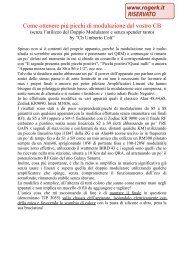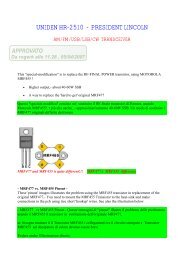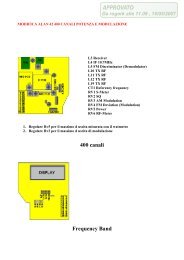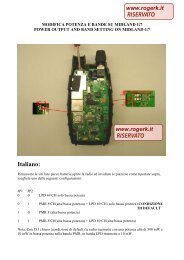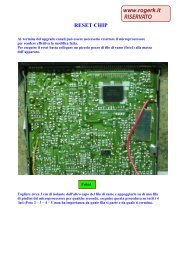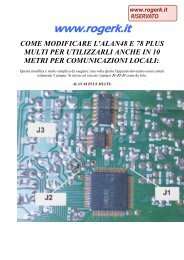Modifications for the ICOM - RogerK
Modifications for the ICOM - RogerK
Modifications for the ICOM - RogerK
- No tags were found...
Create successful ePaper yourself
Turn your PDF publications into a flip-book with our unique Google optimized e-Paper software.
Sub band PSK receive audio! You get Main FM. Grrr!Downlink 1200 bps PSK reception from <strong>the</strong> Sub band receiver is excellent, as too is Oscar-13's 400 bps telemetry signal.The only snag with <strong>the</strong>se PacSats is doppler tracking <strong>the</strong> PSK signal. (See later).9600 bps DFM SatellitesUosat-22, KitSat-23 etc require <strong>the</strong> TXAudio to be applied direct to <strong>the</strong> transmit FM varactor. RXAudio must be picked off directlyfrom <strong>the</strong> FM discriminator, and <strong>the</strong> system is full duplex.Thus <strong>the</strong> internal MOD slider switch needs to be set to PACT. But that immediately picks up <strong>the</strong> wrong RX audio - from FM Main'sdiscriminator. For satellites we need FM Sub's discriminator output.Consequently you CANNOT operate <strong>the</strong> 9600 bps satellites with an Icom IC-820H "straight out of <strong>the</strong> box".There is a solution, but we're back to modifications I'm afraid.What you do is locate <strong>the</strong> Sub receiver discriminator IC20, pin 9 and fly that signal out on your own lead. This requires you toremove <strong>the</strong> big PCB called Main Unit, turn it over and do some fine re-work among <strong>the</strong> Sea of SMD. Alternatively you can pick upa downstream version of <strong>the</strong> signal without removing <strong>the</strong> PCB at <strong>the</strong> optional tone-squelch unit-B socket J20, third pin from <strong>the</strong>"J". Incidentally this signal is DC coupled to <strong>the</strong> discriminator chip, so you can implement closed-loop AFC externally using one of<strong>the</strong> many published circuits. The source impedance is 47K (R329).I checked Uosat-22 and KitSat-23 on Sub-band using this modification. The UO-22 "eye" is poor when it leaves <strong>the</strong> satellite, witha lot of LF flutter which has always made decoding difficult. But <strong>the</strong> 9600 bps per<strong>for</strong>mance of <strong>the</strong> Sub band receiver is so good itadds little extra aberration and data decoding was quite satisfactory. The KitSat-23 "eye" was wide open, and data detectionperfect.Since <strong>the</strong>re is no AFC indication <strong>for</strong> Sub band, tracking <strong>the</strong> changing doppler shift unaided requires ei<strong>the</strong>r very good judgement,an external system as above, or computer control.Oh, and once again set <strong>the</strong> mic gain to zero, or microphone sounds will be added to your transmission.9600 bps DFM TerrestrialTerrestrial 9600 bps packet works perfectly, "right outa <strong>the</strong> box".Over <strong>the</strong> last six years I've tested innumerable radios <strong>for</strong> 9600 bps operation. The Icom IC-820H now shares top place withKantronics' D4-10. (The latter is however 2-channel, crystal controlled and UHF only).9600 bps packet requires <strong>the</strong> TXAudio to be applied direct to <strong>the</strong> transmit FM varactor. RXAudio must be picked off directly from<strong>the</strong> FM discriminator, and <strong>the</strong> system is simplex.Thus <strong>the</strong> internal MOD slider switch needs to be set to PACT, which also selects RXAudio from FM Main's discriminator.The transmitter circuit's frequency response is from about 15 Hz to well beyond 6 kHz, so <strong>the</strong> outgoing signal has superb fidelity.If <strong>the</strong> drive signal exceeds 1.6 volts pk-pk, corresponding to about +/- 5 kHz deviation, modulation is switched off abruptly andstays off until you reduce <strong>the</strong> drive. A nice touch. The correct drive level is 1 volt pk-pk <strong>for</strong> +/- 3 kHz deviation and I confirmedthis by measurement.The FM Main and Sub receive circuits are similar. Main uses a pair of Icom part no. FL-211 crystal roofing filters (no spec) and amuRata SFH455E ceramic final filter; Sub uses a pair of FL-212 and <strong>the</strong> muRata CFW455E. The "E" suffix means 15 kHzbandwidth. The SFH types have particularly flat delay characteristics, and are pin compatible with <strong>the</strong> more common generalpurpose CFW series.Main's fidelity is outstanding, with a flat frequency and delay response to over 6 kHz. The "eye" was essentially perfect. You canbe mistuned by up to +/- 4 kHz be<strong>for</strong>e <strong>the</strong> "eye" starts to look mangled, and +/- 5 kHz if <strong>the</strong> packets are short. The Sub receiveris almost equally good, but you can't get at it without modifying <strong>the</strong> radio as described earlier.No quibble with Icom's claims here; 9600 bps simplex works 101%.PSK Satellite Doppler TrackingWhen using a 1200 bps PSK digital satellite such as FO-20, PacSat, Lusat or Weber it is essential that <strong>the</strong> PSK modem cancontrol <strong>the</strong> radio receive frequency in a closed loop fashion, preferably in small steps. The universal means of doing this is via<strong>the</strong> Up/Down buttons of <strong>the</strong> microphone socket.The smallest step from <strong>the</strong> mic Up/Down buttons of <strong>the</strong> IC-820H is 100 Hz. This really is too big, as <strong>the</strong> sudden lurch from onefrequency to <strong>the</strong> next will invariably cause momentary loss of demodulator lock, with attendant corrupted characters.The Up/Down line is also accessible from <strong>the</strong> accessory socket, but it shares a pin with <strong>the</strong> ALC control. You select which from aninternal slide switch.




